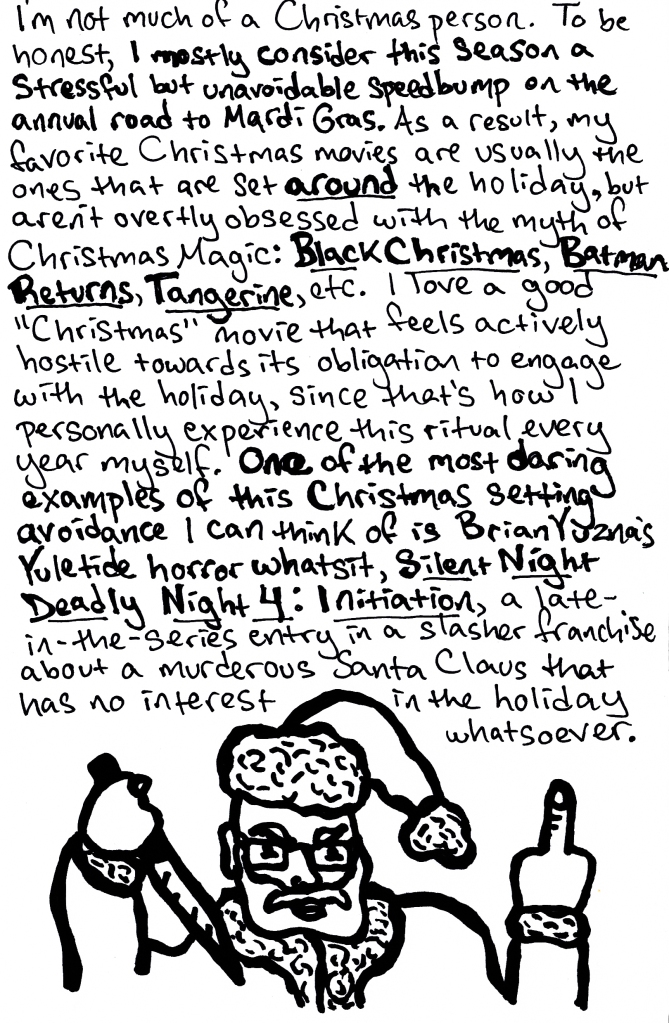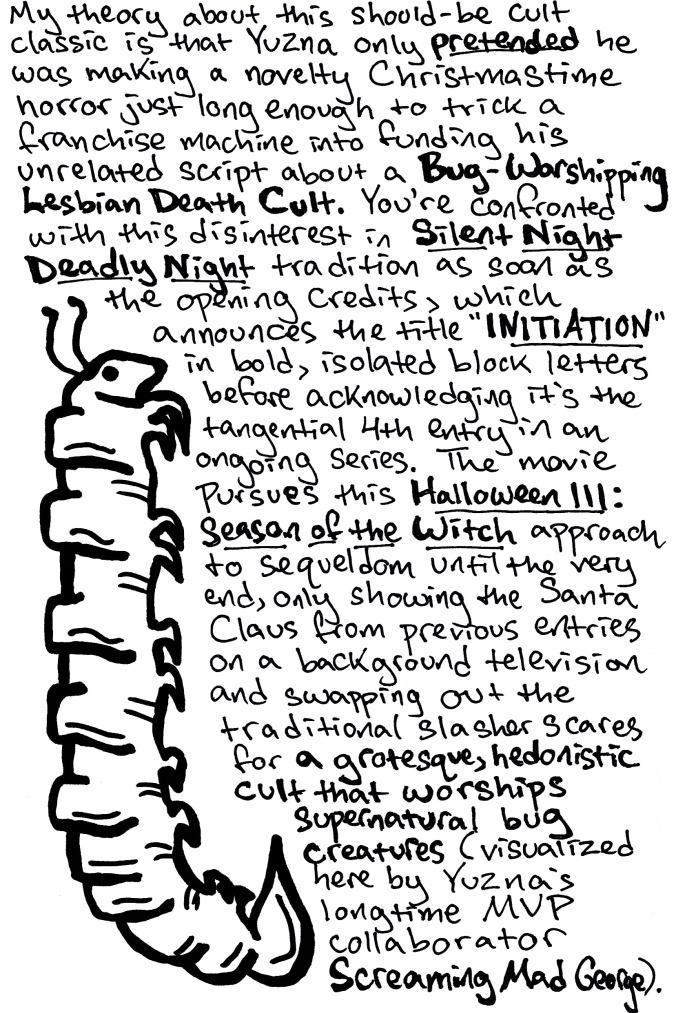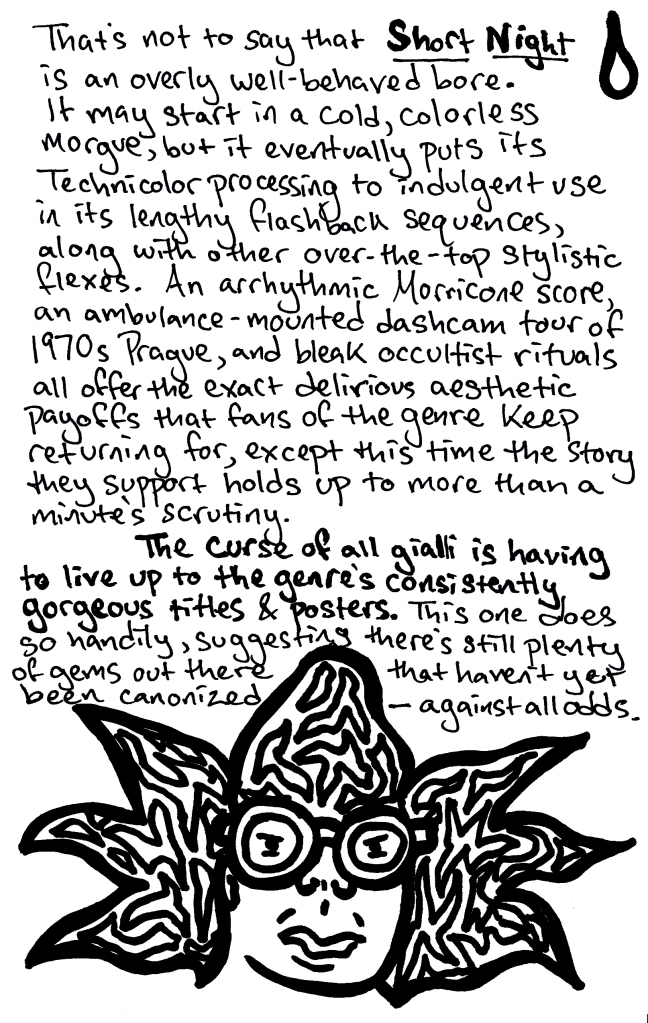

A few years ago, I did a write up on Goodnight Mommy, the debut fictional film of directors Veronika Franz and Severin Fiala, which the duo have followed up on with The Lodge; there’s a really great fake title that I would love to give to The Lodge that fits perfectly but spoils the ending. I would love to give it away here, but I’ll refrain (but look for it in the tags of this post). Originally slated for release at the end of last year, I assume it was moved to an early 2020 release date to avoid competing with Doctor Sleep for the contender of heir apparent to the legacy of The Shining (they needn’t have bothered, given that nobody bothered to see Doctor Sleep despite it being great). Like The Shining before it, The Lodge delves deep into manifesting loneliness and isolation, and the maddening affects thereof, as a vast wintry landscape with no apparent end in sight.
Teenage Aidan (IT and Knives Out‘s Jaeden Martell) and younger sister Mia (Lia McHugh) Hall are displeased at their father Richard (Richard Armitage)’s plan to marry Grace (Riley Keough). Their mother Laura (Alicia Silverstone) took the news that Richard planned to finalize their divorce and remarry more poorly, killing herself and leaving young Mia inconsolably and existentially terrified about the fate of her mother’s soul, which Richard is ill-equipped to handle. He plans to move forward with his relationship with Grace regardless, and, intent on getting the kids to bond with her, takes the whole family to their remote Massachusetts lodge for Christmas. The Hall children are understandably (if unkindly) suspicious of Grace because of her past: at age 12, she was the lone survivor of a mass cult suicide that was orchestrated by the cult’s fundamentalist leader, her father; she and Richard met because she was the subject of one of his books*. Richard leaves the three alone in the titular lodge while he attends to a work obligation and plans to return before the holiday.
It’s not a pleasant time for Grace. She decorates the lodge for Christmas as the kids sullenly choose not to help her. The abundance of Christian iconography on the walls (a portrait of Mary that hangs over the dining table, crucifixes all over the place) also triggers her PTSD, and even her medication doesn’t prevent her from having recurring nightmares featuring images from her childhood. As she dreams, she relives the experience of finding the dead bodies of her father’s followers, mouths duct-taped and adorned with the word “sin” and covered with purple cloths, and she is haunted by the image of her father’s maniacal face and firebrand evangelism. Aidan is the most hostile, but Mia starts to warm to Grace and befriends Grace’s dog Grady (also the name of the previous caretaker of the Overlook in The Shining) and after Grace falls through ice and nearly drowns while retrieving Mia’s doll, a replica of the girl’s dead mother. Keough delivers a nicely understated performance in a scene in which she tells Mia about wanting a dog when she was young and how her father forbid her from having anything of her own, and that Grady represents her independence and self-reliance.
Snowed in on the night of the 22nd, the trio falls asleep around a gas heater during a double feature of The Thing and Jack Frost. When they awake the next morning, the Christmas decorations have disappeared, as has all of the perishable food, as well as everything of Grace’s. Aidan tells Grace that he dreamt that the family suffocated. Grady has disappeared, the power is out, clocks seem to have jumped ahead to January 9, and all of the phones in the house are dead. Without her medication, Grace’s mental state deteriorates rapidly, and she eventually attempts to walk to the next town for help despite the children warning her that she’ll never make it. After encountering a seemingly abandoned cross-shaped building in the endless snowscape and imagining that her father is inside, Grace is heartbroken to find that she has walked in a great circle and found herself back at the lodge with the kids. Aidan tells Grace that they are dead and in purgatory, and evidence begins to mount that this might be the case.
The Lodge is a pretty decent horror film. I’m a philistine who still hasn’t managed to see Fury Road, so my only exposure to Keough’s previous acting is that episode of Riverdale where Archie and Jughead are riding the rails to escape Hiram Lodge’s wrath (DO @ me if you want to talk Riverdale, dear readers). She carries this film, and young actress McHugh also delivers a surprisingly nuanced performance. Martell is well cast even if the role isn’t terribly demanding on a performative level; there’s not much to Aidan other than “teenager who hates his incumbent stepmother.” Martell’s boyishness lends Aidan an air of innocence; the audience isn’t sure if his actions are merely born out of teenage frustration and grief or some greater malice. Armitage is serviceable in his role as Richard, which is fine. You don’t have much sympathy for a guy who is an incredibly poor father and selectively observant as a partner. He doesn’t seem to be aware that Grace is on extremely vital medication for her issues, is incapable of consoling (or even comprehending) his daughter’s concerns about her mother’s seeming damnation, and sees no issue with leaving her alone with his children (who hate her) for a prolonged period of time. Instead of easing them into the concept of accepting Grace as his new life partner, he pulls emotionally manipulative stunts on them like inviting her to holiday dinners without giving the kids time to prepare themselves for this upset. Since he knows full well that he will likely have to work during the holidays, he essentially sets up a situation in which his children will be left alone with his fiance, like an experiment to see if he can be as far removed from the situation as possible while all of the unpleasant parts that make up the beginning of acceptance take place and he can swoop in and be around for the good stuff. He’s a truly despicable character, and I appreciate both that the film doesn’t shy away from that and that Armitage plays him as a person who really and truly does not realize that he’s a garbage human being.
The weakness of the film is largely in its unevenness. Grace is largely unseen for the film’s first act; when Laura arrives to drop off the kids at Richard’s house for his custody time, she sees Grace’s silhouette through a window and the back of her head as she leaves through a back gate (this is after Richard promised her that Grace would not be present when she arrived, and even lies about whether Grace had been there recently at all). When the kids dig through their father’s research for more information about Grace, we only see her as a child. When Richard attempts to “spring” Grace on the kids at Thanksgiving, we only see her through frosted glass as Richard apologizes and sends her away. All of this is counterposed against Mia’s story. Mia loves and loved her mother, even going so far as to create doll versions of the whole family, which she moves about in an ornate dollhouse that replicates the title location. At her mother’s funeral, when the grieving release balloons in memory of the deceased, Mia frantically tries to tie the ribbon on her balloon to the doll’s hand so that it can get to heaven, metaphorically, and when her balloon drops while the others float away, it devastates her. After all, is that not the metaphorical image of her mother failing to get to heaven, just as Mia fears is already the case, given how Catholicism defines suicide?
When we finally meet Grace in the flesh, it’s as if the narrative wants to say, “Hey, look, she’s not so scary after all. She’s just a person.” I wish that this worked, that we had been dwelling in the perceptions (and preconceptions) of the Hall children up to this point and that the reveal that Grace is a perfectly nice person was a shock. One could argue that this is the point, but the children never seem to fear Grace. They hate her, they blame her for their mother’s death, but they never seem to be afraid of her (until it’s too late). That end of Act I/beginning of Act II switch then makes Grace the main character, and Mia moves mostly into the background as the film becomes more about the conflict between Grace and Aidan, with his sullenness and inappropriate behavior (like watching Grace shower) making it more difficult to sympathize with him, while Grace makes an admirable attempt to maintain her composure and sanity as she withdraws from her medication and starts sleepwalking and hearing her father’s voice. Is it just her PTSD? Or is it something more?
You get the answer to that question, but I had the same problem with this one that I had with Goodnight Mommy; in that review, I mentioned a commenter on another site’s review of the film who advised that “If you haven’t guessed [the plot twist] by ten minutes in, you haven’t seen a movie before.” Luckily, you get a fair bit further into The Lodge before the “twist” becomes obvious; I was along for the ride until the clues started to pile up in one direction. There’s also more to the falling action here than there was in the duo’s previous film: by the time you learn “the truth” in Goodnight Mommy, there’s barely ten minutes left to explore the ramifications of that, but The Lodge lets the cat out of the bag at the beginning of Act III and spends more time on consequences. It’s unfortunately predictable, but it wears its horror influence on its sleeve, and there are no bad performances, with McHugh and Keough providing a strong backbone when the strength of the narrative atrophies a little. There’s no rush to see it on the big screen, but it’s worth a watch.
* According to the Wikipedia plot synopsis, Richard is an investigative journalist. The film does not make this completely clear; both I and my companion thought he was a psychiatrist or psychologist, and had specifically treated Grace (the only line of dialogue that we really get which clarifies their relationship is an offhand reference one of the kids makes to Grace being in one of their father’s books). Richard is a terrible father, and we didn’t put it past him that he would have a relationship with a patient. Him being a journalist makes slightly more sense and is less ethically questionable, but he would have to be making medical professional money to afford both a lodge and such a fancy modern house.
-Mark “Boomer” Redmond
















